Field, John (McKechnie Section 2)
See also Sections Four, Five, and Six; also entries on Miers, John, and on Miers (William) and Field, in Sections Four and Five
One of the finest and most famous of silhouette artists, recorded by Jackson (The History of Silhouettes and Dictionary) and the other standard authorities on silhouettes. The multiplicity of entries in other Sections, to which readers are referred, is necessitated by three circumstances: Field's own wide range of media; his first period spent as assistant to John Miers; and his later period (probably 1823-29) spent in partnership with Miers' son William, after which he worked under his own name, although with his son.
I have seen from the Field family Bible that John Field's parents, William and Ann (née Bird,) were married at the parish church of St Ann's, Westminster, on 31 May 1767. There were three children of the marriage: William (1769-88); John, the silhouette artist (born probably in London on 24 January 1772 'near 4 o'clock in the morning'); and Sarah (born in 1774). It was Sarah who kept the family Bible records. I have seen similar records by John Field's wife, Mary, in her prayer book. Mary Field (née Harris) was born on 6 April 1774, and died on 22 December 1869 at 2 Strand, in her ninety-sixth year.
As the artist's parents were married in Westminster, it must be concluded that his mother, at least, was a Londoner. John Field himself was married on 24 May 1795 at St Margaret's, Westminster.
As I have mentioned above, Field began his career as an assistant to the great silhouette artist John Miers, but the exact date when he first began painting profiles for Miers is unknown. It depends on whether the 'X' work discussed in the main entry on John Miers in Section Four was in fact by Field. If so, then Field was painting black silhouettes for Miers by 1791. He was certainly doing so by c. 1794, and thereafter he was certainly responsible for most of the silhouettes painted at Miers' studio at 111 Strand, London.
It is not known where Field and his wife lived when they were first married. Field sent in exhibits to the Royal Academy in the years 1800-1804 from Miers' studio address. Another exhibit (1807) was sent in from 7 Great Newport Street, and I own a profile of William Pitt, taken almost certainly in c. 1807, which shows this last address erased and '25 Strand' substituted.
751
Field may have been living since his marriage at the former address, and moved in c. 1807 to 25 Strand. No rate books show Field's name at either address, so he was presumably a tenant. The Great Newport Street address is also on a silhouette of a woman in the Victoria and Albert Museum. The sitter may well have been Lady Hamilton; if so, the silhouette may have been painted as a stock selling line in c. 1806, when Lady Hamilton would have been much in the news after the Battle of Trafalgar on 25 October 1805.
195
By 1807, three children had been born to the artist and his wife. The eldest was Mary Ann (1796-1857). She married Edmond T. Parris, the well known Victorian painter whose works include London from the Cross of St. Paul's, the Colosseum Panorama. In December 1873 the following obituary on Parris appeared in the Daily Telegraph: 'On the 27th. ult, at Francis Street, Bedford Square, most deeply regretted, E. T. Parris, Esq., Historical Painter to her late Majesty the Queen Dowager. Friends are requested to accept this information.'
The second child was Henry John (who, born in 1800, died within a year); the third, Eliza Jane (born in 1804), who married a widower, Louis Adolph Hine, in 1854. The fourth child was Henry William Field (1810-82), the silhouette artist (see Section Five). Since John Field sent into the academy in 1809 from 25 Strand, it may have been at this address that his fourth child was born. Silhouettes of the Field family are illustrated by Jackson (The History of Silhouettes). In this Section, under H. W. Field, is illustrated a black profile of Mrs Harris, John Field's mother-in-law, and in Section Five a silhouette of Mr Harris is illustrated.
747, 1465
I own a profile of a man, on ivory, taken apparently in c. 1815, inscribed on the back 'By J. Field, 25, Strand, and No. 6, Brydges Street, Covent Garden'. At this time the Brydges Street address may have been a temporary residence. There recently appeared for sale at Sotheby, Parke Bernet and Company, London, two silhouettes bearing a trade label of John Field at 'Mr Jarman's, Jeweller and Watchmaker', at 25 Strand, London. We know from G. H. Bailey's Watchmakers and Clockmakers of the World (1st ed., London, N.A.G. Press, 1929) that John Bowkett Jarman was in London in 1815, and F. J. Britten (Old Clocks and Watches and their Makers) amplifies this information by a statement that John B. Jarman was at 25 Strand 1815-23. This label also states that Field was then 'late fourteen years sole profile painter for Mr Miers, of 111, Strand'. Field had either worked or lived at 25 Strand before Jarman's day, for in 1809 he sent in to the Royal Academy an exhibit from this address, which I have already mentioned in connection with a profile of Pitt. He was certainly working earlier than this for Miers, having sent work in to the Academy from 111 Strand in 1800. Furthermore, other examples bearing Miers's labels and dating, to judge from their appearance, from the 1790s, seem to be his work. Other work of the 1790s done at Miers's studio has been referred to in the entries under his name as 'X' work, and it seems that the artist responsible had left Miers's studio at the latest by 1801, leaving Field as the only profilist there. This 'fourteen years' tallies with later press announcements of 1830 and 1840, which give periods of 'nearly 30' and '40 years' of sole work as profilist at Miers's studio.
This label appears to indicate a brief attempt by Field to work on his own, apart from Miers, but the venture cannot have lasted long, for Royal Academy exhibits were sent in from 111 Strand regularly 1810-29, including three for 1815. Graves (Royal Academy, Dictionary of Contributors) made one small but significant error concerning John Field's exhibits. In 1830, No. 452 was sent in not from 111 Strand, but, according to the original Royal Academy catalogues, from 11 Strand. This is in itself conclusive evidence that the Miers and Field partnership had been dissolved by the early summer of 1830, and as only the name of William Miers is given for 111 Strand in Robinson's Commercial Guide of 1830, it seems that the Fields had left that address by the end of 1829. The Fields lived at 11 Strand, probably as tenants, throughout 1830, 1831 and 1832.
In 1831 a Royal Academy exhibit by Field (No. 549) was sent in from 40 Middle Street, Brighton: possibly only a holiday address.
The Post Office Directory of 1832 gives the name of Field (that is, John Field) as 'Profilist to Their Majesties', at 11 Strand. The same directory for 1833 gives the names of both John Field and his son, Henry William, at 2 Strand. The rate books for St Martin's in the Fields confirm that from 1833 until the house was demolished in 1875 the Fields continued to live at this address, the rates being paid throughout this period by H. W. Field. By 1833 John Field would have been sixty years old; no doubt he considered it more convenient that his son should be the householder when at last the Fields acquired their own home. It can therefore be concluded that father and son worked at 11 Strand only from the beginning of 1830 until the end of 1832.
Silhouettes by John Field have been seen bearing the address 47 Craven Street, and Pigot's Directory for 1832 lists the name of John Field at this address. This circumstance is explained by the fact that 47 Craven Street was a corner house: one side faced the Strand, and was numbered 11 Strand; the other side faced Craven Street, and was numbered 47 Craven Street. The two addresses, therefore, indicated the same house, and any silhouette inscribed '47 Craven Street' dates from the same period as those inscribed 11 Strand'.
One mystery of Field's career, which Mr Percy Higgs has spent much time in trying to solve, is the matter of his appointment as profilist to Queen Adelaide and Princess Augusta. The Lord Chamberlain has been unable to trace any record of this appointment, nor do any silhouettes of these royal personages, taken by Field, appear to have been recorded, although he took fine bronzed profiles of George III. Nevertheless, in an article in the Connoisseur (John Field, Profilist', November 1931) Jackson quoted an advertisement (reprinted in her Dictionary) which was issued by John Field, and in which the wording of such a Royal Appointment (granted on 24 August 1830) is quoted in part: Jackson gives the date of this advertisement as 22 May 1831, which was a Sunday. Only two London newspapers, however, were published on this day, and neither of them includes this advertisement, the text of which reads as follows:
The Queen's Profilist. Her Majesty has been pleased, by the following warrant, to appoint Mr. JOHN FIELD, of No. 2 Strand, her Profilist, which distinguished mark of honour has already been conferred on him by H.R.H. the Princess Augusta: as also His Present Majesty's Royal Permission (signified to her Royal Highness) permitting Mr. F. to be his Majesty's Profilist.
Mr. Field's specimens, illustrative of his lovely practice in this branch of art, are very extensively before the Nobility and public. He was the sole Artist for the late Mr. J. Miers for nearly 30 years!!!and also subsequently, in the late Firm of MIERS AND FIELD. Mr. FIELD now continues his profession on his own account, at No. 2, Strand, where profiles are taken in a sitting of five minutes only, even to the minute size of a ring. As Mr. FIELD preserves the original outline, he can furnish copies without a second sitting.
ADELAIDE R.
Whereas we have thought it fit to appoint John Field to be our Profilist during our Pleasure; our Will & Pleasure therefore is, that in making out the Establishment of our Household, you do enter in as such therein and for so doing, this being Registered in your office, shall be to you a sufficient Warrant. Given at St. James' the 24th. day of August in the first Year of the Reign of our dearest Lord and Husband.
By Her Majesty's Command, John Barton
[the Royal Seal]
To John Barton, Esq., our Right Trusty and Right Well Beloved Treasurer.
No. 101, Entered in the office of John Barton, Esq., Her Majesty's Treasurer 24 August 1830. Chas. Goodman.
Whatever was the actual date of this advertisement, it must have been inserted after the beginning of 1833, since it gives the address as 2 Strand. It certainly did not appear in any London newspaper dated 24 August 1834. The Royal Appointment must have been conferred during the period 1830-32, for trade labels of John Field used at 11 Strand during these years show, after the printed phrase 'By Appointment', the words To Their Majesties' handwritten in ink.
John Field lived at 2 Strand until his death. It will be seen from the list of his Royal Academy exhibits, given below, that the artist appears to have visited various parts of the country, where no doubt he made many sketches on which he based the more finished pieces which he sent in to the Academy. I own one of his sketch-books, illustrations from which are reproduced in this Section.
That he was still producing silhouettes as late as 1840 is shown not only by directory entries (see under H. W. Field, Section Five), but also by the following advertisement, quoted by Jackson (Dictionary), who states that it appeared in a London newspaper of that year:
FIELD'S PROFILE LIKENESSES.
FORMERLY MIERS AND FIELD.
These Profiles, so extensively Patronized for the superiority of Likeness, Character, and finishing in bronze and in relief, have been solely executed for the last 40 years, to the present period, for the late Mr. Miers and Son, by Mr. Field, No. 2, Strand, two doors from Northumberland House, and are continued by Mr. F. in all their variety of sizes. Taken in five minutes and duplicates supplied (if required) at any time for Rings, Bracelets (superseding cameos) Brooches, secret Lockets, Cases, Frames, &c. or copied from his former works and other profiles. Or mounts, miniature frames, and cases made. Artists supplied.
Although few examples actually dated in the 1840s have been noted, Major M. McI. Ayrton owns a fine silhouette of Lieutenant-Colonel Richard Willington(1792-1870), of the 84th Foot (later the Yorkshire and Lancashire Regiment). This silhouette, bearing Trade Label No. 3, is inscribed on the back, in John Field's hand, 'by J. Field, 2, Strand, Septr. 1847.' It is painted in sepia and yellow ochre body colour, with the badge of rank shown in Chinese white. There is no gold paint. The piece is as fine as examples painted many years earlier in Field's career, although painted when he was seventy-five, only about fifteen months before his death.
John Field's death, which occurred on 18 December 1848, was recorded in the family Bible as follows:
'John Field, born 24th. Jan., 1772 at 4 o'clock am, died 18 Dec., 1848 in the 77th. year of his age, having married Mary Harris (born 6th. June, 1774), May 24th., 1795, at the Parish Church of St. Margaret, Westminster, and died Tuesday, 22nd. December, 1869, in the 96th. year of her age. The above John Field and his wife had issue ...' The reference to the death of the artist's wife, twenty years after his own, may have been added by a member of the Field family of a later generation, since John's sister Sarah (the date of whose death is unknown) would have been in her mid-nineties in 1868. Nevertheless, Sarah's own death is not noted in the Bible, and she may indeed have written this entry at an advanced age.
The pantograph used by John Field, and probably used later by his son, is in my collection, as is a box which he owned containing pieces of gold leaf which he may have used for bronzing silhouettes. Both are illustrated in Chapter Two.
7, 15
I give below a list of works by John Field exhibited at the Royal Academy. It is taken from the original Royal Academy catalogues, and differs slightly from the list given by Graves (Royal Academy, Dictionary of Contributors). It will be seen that occasionally Field, while working for Miers, sent in works from his own address, though more often he sent them in from the address of Miers' studio.
From 111 Strand
1800 (No.) 779 View of the Serpentine River
1803 685 Rippon — A Study
1804 671 View in Buckinghamshire
672 View in Hyde Park
From 7 Great Newport Street
1807 624 View in a Lane near Chertsey
From 'at Mr. Miers, 111, Strand'
1808 421 A View on the Sea Coast
From 25 Strand
1809 477 A pencil sketch from Nature
From 'at Mr. Miers' 111, Strand
1810 344 possibly View of the Peak Canal,
Derbyshire (Graves)
349 A View over the Thames
1811 262 Evening: a Study from Nature
1813 647 A Portrait (Graves gives A Landscape.)
1814 644 A landscape, painted on plaster of paris
648 As above
1815 658 As above
669 As above
681 As above
1816 654 View between Hampton Court & Ditton
(on plaster of paris)
672 View in Monmouthshire
(on plaster of paris)
1817 569 Landscape on plaster of paris
574 As above
1818 626 View from Thames Dillon looking towards
Hampton Court (on plaster of paris)
631 A Landscape —Evening (on plaster of paris)
638 View on the Coast — Morning
(on plaster of paris)
1819 685 A Landscape (on plaster of paris)
998 View in Pembrokeshire (on plaster of paris)
1820 866 A Pass (described as 'In the Andes, S. America')
872 View on the Kentish Coast
1821 463 Landscape — Evening
1822 811 A Landscape (on plaster of paris)
841 Thames Dillon Ferry, looking towards Kingston
1823 524 Cottages at Henbury, near Blaze Castle, Gloucestershire
530 Distant View of Penarth Point, near Cardiff
1824 535 View on the Bristol River, near Rownham
1825 427 Stoke House, Stapleton
768 Part of the Lawn and Keep, Cardiff Castle
1826 716 Newport, Monmouthshire
1829 498 River Scene — Evening
From 11 Strand; listed as 'Profilist to H.R.H. Princess Augusta'
1830 452 Landscape Composition (on plaster of paris)
(Graves gives Rownham Ferry, from Clifton.)
From 40 Middle Street, Brighton
1831 549 Winkle Gate, Southampton
From 2 Strand
1835 441 Chalybeate Well, High Harrow gate
448 View in High Harrowgate Common, Yorks
(The original sketches for these two pictures
are in a sketchbook of Field's in my collection.)
From 2 Strand, listed as 'Profilist to Their Majesties and H.R.H. Princess Augusta'
1836 664 Landscape a la Silhouette
(This showed upwards of 25 silhouettes in detail.)
John Field had a long career. A few of the illustrated examples of his silhouettes painted on card date from his years at 111 Strand. Others date from the years when he worked independently and bear his own trade labels, first at 11 Strand, and later at 2 Strand.
Most of this work was bust-length. Only rarely have full length examples been seen; I own one (of William Pitt) which I acquired from a descendant of the artist, and another (of a man and a woman) was illustrated by Coke, who owned it, in Confessions of an Incurable Collector.
752
The profile of Pitt is painted in fine strokes of sepia against a pale umber base colour. It is signed merely 'Field pinxt.' Pitt died on 23 January 1806, during that year many busts, portrait medallions and other images were produced in his memory. This full length silhouette of the statesman was probably painted as yet another memento, and kept for his family. Other examples may have been painted for sale, though only among Field's friends, since, at this time, he was working for John Miers in his studio, and commemorative silhouettes painted for sale in quantity would have been signed 'Miers'. This silhouette, when I acquired it, was in an ill-fitting maple frame. It was backed with a large pencil drawing, The Miller's Home, probably also Field's work, though he appeared to have considered it of little merit, since it was cut in half to fill in the gaps at the side of the mount.
The group owned by Coke was a different matter. Signed and labelled by Field, and dating from c. 1836, it was certainly painted for sale, and others like it may exist. It is well painted almost entirely in black, except for a thin line of white indicating the man's collar. He is standing, gesticulating with his hands, while his lady companion is seated, holding on her lap a book and spectacles. Only her babet cap, with its bows beneath the chin, is painted in a fine transparency of thinned pigment. The figures are shown on planked flooring, which does not reach to the bottom of the portrait.
It is unlikely that unsigned or unlabelled full length work would be found; Field was methodical as far as signing his work was concerned. The brush work on the heads and shoulders of the sitters on any examples with obliterated signatures, however, would be distinctive enough to reveal Field's hand; this is clearly shown on some of the illustrated bust-length examples. These bust-length profiles are painted in a variety of styles. Field painted in plain black; one example (of a man) set in a pocket-case, is illustrated, and the sitter's frill corresponds with the frills illustrated in the magnification photographs shown in Section Four.
753, 1449, 1450
Field probably painted this profile while working for John Miers. He also painted silhouettes of men in black, leaving the cravat and stock white and adding detail in thinned pigment.
Two illustrated profiles, signed 'field' and taken C. 1806-1807, are painted against a base colour of pale umber, with detail added in fine strokes of sepia. Both are in oval frames of turned wood, and bear on the back, private addresses of John Field, written in his own hand. One of these, of William Pitt, was painted after a bust by Joseph Nollekens, who produced 'stock' busts of both Pitt and Fox.
751
That of Pitt he took from a death-mask; the sculptor apparently sold seventy-four replicas of this bust at £120 each (Rupert Gunnis, Dictionary of British Sculptors, 1660-1851, London, 1953). Field's silhouette is signed 'Field' on the front. On the back is written 'Rt. Hon. Wm. Pitt/Painted from the Bust/of Mr. Nollekens by John Field/25. Strand.' The words 'by Mr. Nolleken's private permission' were crossed through, as was the address at 7 Great Newport Street, which was altered to 25. Strand. A small label, attached to this interesting piece, reads (on one side), 'William Pitt. b. 1758 d. 1806. Prime Minister in 1783. aet. 25' and (on the other), 'A Kingdom entrusted to a school-boy's care'. This label, apparently not in Field's hand, was probably added by a patriotic owner of bygone days, who erred in the matter of the year of Pitt's birth (the statesman was born in 1759).
The second of these sepia profiles is of a woman (almost certainly Lady Hamilton, I think). It is inscribed on the back 'Painted by J. Field/No. 7, Gt. Newport Street, London.' Like the silhouette of Pitt, this may be an example of a profile of a well known figure painted for sale 'on the side' by Field.
195
I have discussed Field's style of painting most fully in Section Four (under John Miers) and in Section Five. When painting on card at 2 Strand from 1833 Field sometimes introduced tinted base colours, such as sepia, with painting in blended yellow paint (instead of gold) or (on one example) a dark greenish hue.
140
A consistent 'dip' at the back of bust-line terminations is characteristic of Field's profiles; it is still seen on examples from the 1830s and 1840s.
A competent fake of a silhouette by Field is illustrated in Chapter Two.
17
One remarkable piece which should be noticed here is the print, based on a sketch by Field, entitled The Royal Allied Oak and self-created Mushroom Kings.
758
This shows a tree, whose branches form the outlines of the 'hidden profiles' of members of the British Royal Family and other contemporary public figures, British and foreign. Other profiles are outlined on the ground. The print is inscribed (on the left) 'J Field delta.' and (on the right) 'Published May 29, 1815 by J. Jenkins, 48, Strand'. J. J. Jenkins (1811-85) may have been a descendant of the publisher. Below the picture is a poem:
Behold the Oak, whose firm fix'd stay
Doth check Oppressions's course.
Whose slightest breath can ne'er decay
While strong with Virtue's force.
Our much loved Sovereign decks this branch
The highest of the Tree:
And peaceful Lords tho' driven from France,
Among its boughs you'll see.
The Regent's Portrait next behold
Whose councils Wisdom guides;
And Russia's noble Monarch bold,
Who checked the Tyrant's strides.
Immortal Wellington next is seen,
Whose fame can ne'er expire;
And veteran Blucher's warlike mien
That kindled Napoleon's ire.
The Mushroom Race you have to seek
In weeds about the Root.
Who scarce dare at the Oak to peep
Or at its Princely Fruit.
I should also mention the drawings in one of Field's sketch-books. Most of these are in pencil, but some are in pencil and Indian ink. Almost all are landscapes, bearing inscriptions, in the artist's neat hand, stating the locality depicted. Most of them represent the surroundings of Harrogate. The sketch-book (probably only one of several which Field used) is covered in old brown paper; the sheets measure 7 x 13 in. There is also in my collection an unfinished drawing of a seascape, inscribed on the back 'On the East Cliff, Ramsgate, 7th. Sepr. 1840, J. F.', and (in a large cursive hand) 'Mr. Field, 2 Strand'. Since Field sent in two landscapes of 'Harrowgate' to the Royal Academy in 1835, he must have visited the area at some time in the 1830s. Among the drawings in the Harrogate sketch-book are the following: Chalybeate Spring, High Harrogate (exhibited at the Royal Academy, in its finished form, in 1835); Thompson's Observatory, Harlow Hill; Low Harrogate Church; Galpha, the residence of Mr. Coates, Esq.; View of the Granby, High Harrogate, and The Swan Inn.
As will be noted from the list of Royal Academy exhibits, Field painted many of his landscapes on plaster, a surface on which he painted silhouettes with great dexterity. Some of these landscapes were in colour, others in monochrome (there is a fine example of the latter in the Christie collection).
761
Turning to Field's trade labels, we are only concerned here with those which bear his own name.
762-766
I have already mentioned one of these, used c. 1815 at 25 Strand:
FIELD
MINIATURE PROFILE PAINTER
AT
Mr. Jarman's, Jeweller and Watchmaker
25, STRAND, LONDON
(LATE FOURTEEN YEARS SOLE PROFILE PAINTER FOR MR. MIERS
OF 111 THE STRAND)
TAKES strong Likenesses in Profile Shades in a Style peculiarly New and Improved, Whereby the Resemblance and Symmetry are pleasingly united, which are reduced for Rings, Broaches, Lockets, Snuff Boxes, Tooth-pick and Pocket Cases, Frames, &c., at 10s. 6d. each.
Mr. F. preserves the Original Outline of those who have once sat to him for five minutes, and can supply any number of Copies (if required) without a further Attendance.
Profiles accurately Copied, and Miniatures elegantly Framed
This, Trade Label No. 1, was in use much earlier than the remainder of Field's labels, all of which were printed for his independent work, first at 11 Strand and later at 2 Strand.
The two labels used on silhouettes in papier mâché frames are listed first, three small labels used for silhouettes set in jewellery or on boxes (sometimes used on work in papier mâché frames, probably when stocks of the larger label were exhausted) follow. Nos 2 and 5 were used at 11 Strand, probably from the beginning of 1830 to the end of 1832. Most examples of these two labels bear the words 'To Their Majesties', added in handwriting, although examples dating from the early 1830s have been seen without them. Nos 3,4 and 6 were used at 2 Strand from the beginning of 1833. All five labels are illustrated.
The text of Trade Label No. 2 reads as follows:
J. FIELD
PROFILIST
By Appointment to Their Majesties
[these words handwritten]
(&) to H.R.H. the PRINCESS AUGUSTA
No. 11. Strand, London
Corner of Craven Street, near Northumberland House Upwards of Thirty Years sole Profile Painter, and late of the firm of Miers and Field.
Continues to execute his long approved Profile Likenesses, on an improved style of elegance, with the most perfect and unequalled degree of accuracy, as to give the most pleasing resemblance and character, for Frames, Cases, Frontispieces for Literary Works, and even the minute sizes for Bracelets, Brooches, Lockets, &c.
TIME OF SITTING, FIVE MINUTES
Mr. F. preserves all the Original Shades, by which he can at any time furnish copies if required, without the necessity of a second sitting. Copies correctly taken from Profiles, Out‑lines, Busts, &c.
Miniature Frames and Cases of every description
Manufactured by H. W. FIELD
JEWELLERY AND SEAL ENGRAVING.
The illustrated example of Trade Label No. 3 is printed on white paper, but it has also been seen printed on green paper. The text is as follows:
J. FIELD,
PROFILIST,
BY APPOINTMENT,
To their MAJESTIES and H.R.H. the PRINCESS
AUGUSTA
No. 2, STRAND, LONDON,
TWO DOORS EAST FROM
NORTHUMBERLAND HOUSE,
Upwards of Thirty Years sole Profile Painter, and late of the firm of
Miers and Field,
Continues to execute his long approved Profile Likenesses, on an improved style of elegance with the most perfect and unequalled degree of accuracy, as to give the most pleasing resemblance and character, for Frames, Cases, Frontispieces for Literary Works and even in the minute sizes for Bracelets, Brooches, Lockets &c.
TIME OF SITTING, FIVE MINUTES
Mr. F. preserves all the Original Shades by which he can at any time furnish copies if required without the Necessity of a second sitting. Copies correctly taken from Profile Out‑lines Busts etc.,
Miniature Frames and Cases of every description
Manufactured by H. W. FIELD; also
JEWELLERY AND SEAL ENGRAVING.
Trade Label No. 4 reads:
By Appointment.
J. Field.
Profilist
To their Majesties Sc H.R.H. the Princess Augusta.
No 2 Strand, London
Two doors East from Northumberland House.
Upwards of Thirty Years sole Profile Painter and late of the firm of Miers & Field.
Continues to execute his long approved Profile Likenesses combining Expression and Character with accuracy of Finishing so as to give the most pleasing resemblance. For Frames, Cases, Frontispieces for Literary Works and even in the minute sizes for Bracelets, Brooches, Lockets &c.
Time of sitting five Minutes
Mr. F. preserves all the Original Shades, by which he can at any time furnish copies if required, without the necessity of a second sitting. Copies correctly taken from Profiles, Out‑lines, Busts etc.,
Miniature Frames and Cases of every description manufactured
by H. W. FIELD, also
Jewellery and Seal Engraving.
The illustrated example of Trade Label No. 5 (used at 11 Strand) is from a small box, containing gold leaf used by Field, in my collection (illustrated in Chapter Two).
7
The phrase 'To Their Majesties' was added in handwriting to the printed details of the Royal Appointment. As I have mentioned, Trade Label No. 6 (used at 2 Strand) was, like No. 5, used mainly for jewellery pieces, but the illustrated example was found on the back of a silhouette in a papier mâché frame.
Four specimens of John Field's signatures are illustrated.
767-770
Ills. 140, 195, 750-770
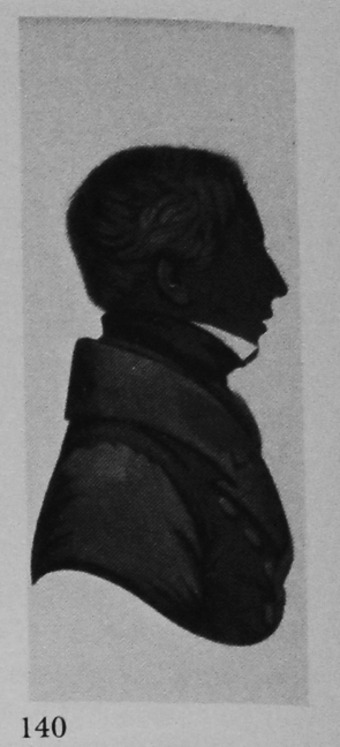
The Reverend Perkins, Junior, J.P.
Silhouette by John Field, c. 1835.
costume dating points
The hair, cut close at the back, with some of a side parting on the left.
The dark cravat of the 1830s, of the mail-coach type.
This is probably the top of a double-breasted frock-coat, for the tail-coat of the time had a collar higher at the back than this. There is still some gathering at the shoulders.
Author’s collection
Chapter 7
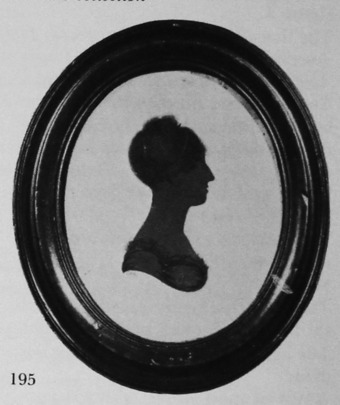
Unknown woman (possibly Emma, Lady Hamilton).
Silhouette by John Field, probably 1807. (The silhouette bears on the reverse Field’s address at 7 Great Newport Street, London; the artist sent work to the Royal Academy from this address in 1807).
costume dating points
The à la Titus hair-style, worn with the popular bandeau.
The dress, with its low, square décolletage, worn without a fill-in.
Crown Copyright. Victoria and Albert Museum, No. P.22-1927
SECTION TWO
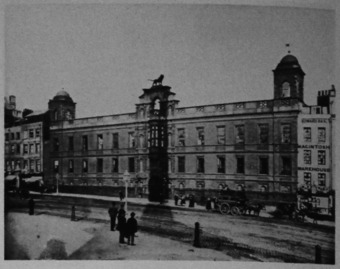
Northumberland House, London, in 1870. No. 2 Strand (John Field’s house, later owned by his son, H. W. Field) is on the extreme left; its location is indicated by the phrase ‘two doors east of Northumberland House’, which appears on John Field’s trade labels.
From a contemporary print in the library of the Guildhall, London
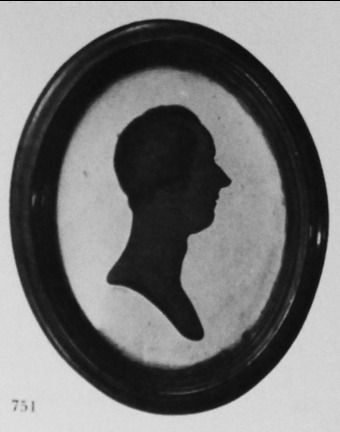
William Pitt
Silhouette painted on card in light umber body colour, with detail in sepia
c. 1807
2¾ x 2¼in./70 x 58mm.
Frame: oval, turned walnut
After a bust, made posthumously by Joseph Nollekens. Inscribed with the address 25 Strand. The back-line at the base is painted, like other details, in fine lines of sepia.
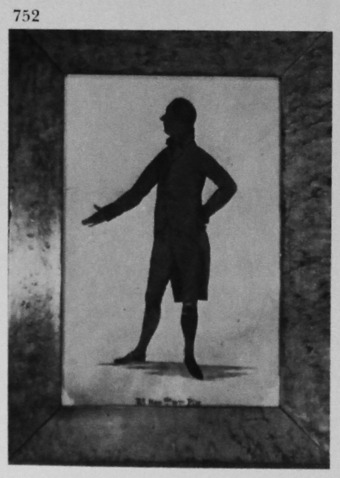
William Pitt
Silhouette painted on card in sepia against a base colour of pale umber body colour
c. 1806-1807
11¼ x 7½in./286 x 191mm.
Frame: maple
Probably painted posthumously.
Signed ‘Field pinxt’.
Author’s collection; acquired from descendants of the artist
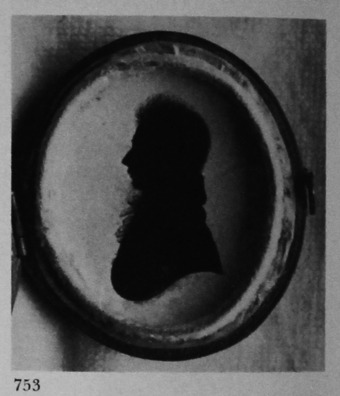
Red leather pocket case, with a silhouette of an unknown man painted on card by John Field, c. 1815.
Size: 1½ x 1¼in./39 x 32mm.
Although the signature was, at this date, probably ‘Miers’, the style is typical of John Field’s work painted in black.
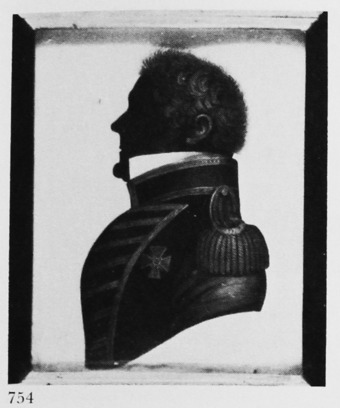
Unknown naval officer of Flag rank
Silhouette painted on card, bronzed
1830-32
3 x 2½in./77 x 64mm.
Trade Label No. 1
Frame: papier mâché
Signed ‘Field, 11, Strand’.
Mr and Mrs J. H. Gutteridge collection
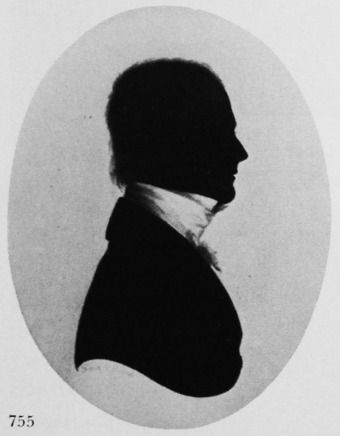
Unknown man
Silhouette painted on card in black
c. 1838
3¼ x 2¾in./83 x 70mm.
Trade Label No. 5
Frame: papier mâché, with copper acorn ring
Signed ‘Field, 2, Strand’. The sitter’s stock is shaded in thinned pigment.
Author’s collection
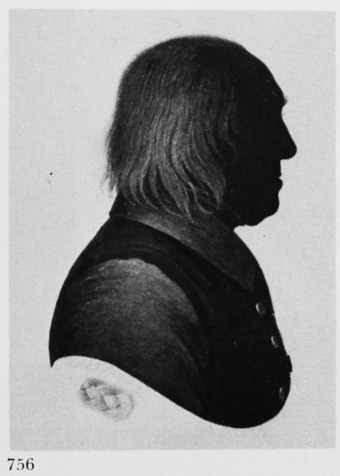
Jeremy Bentham
Silhouette painted on card, bronzed
c. 1833
3½ x 3in./90 x 77mm.
Trade Label No. 4
Frame: papier mâché
Signed ‘Field, 2, Strand’.
Since Bentham died on 6 June 1832, and the silhouette bears Trade Label No. 3, this example was probably painted c. 1833. In the National Portrait Gallery, London, there is a duplicate, in oval format.
M. A. H. Christie collection
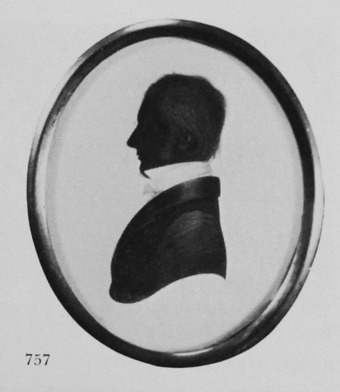
Unknown man
Silhouette painted on card in shades of ochre against a base colour of deep sepia
c. 1838
3½ x 3in./90 x 77mm.
Trade Label No. 4
Frame: papier mâché, with brass acorn hanger
Signed ‘Field, 2, Strand’, in the manner of John Field.
Author’s collection
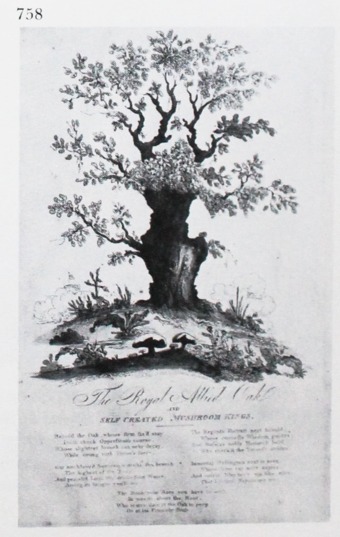
The Royal Allied Oak and self-created Mushroom Kings
Print after a sketch by Field
Date of publication of print: 29 May 1815
Discussed in the text. The branches of the tree form the outlines of a number of ‘hidden profiles’; other profiles are shown on the ground.
From a photograph in the author’s collection, presented by descendants of the artist
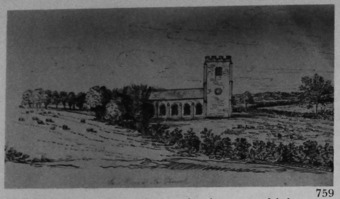
Low Harrogate Church. Drawing in pen and ink from a sketchbook of John Field.
Author’s collection
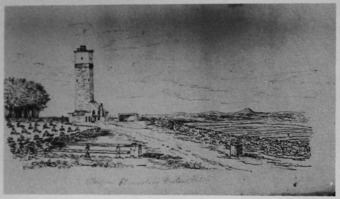
Thompson’s Observatory, Harlow Hill. Drawing in pen and ink from a sketchbook of the John Field.
Author’s collection
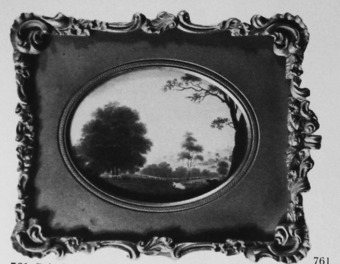
Painting in monochrome on plaster by John Field. Inscribed as having been exhibited at the Royal Academy (no. 655, 1810), although it is not listed by the standard authorities.
Size: 2 3/8 x 3in./161 x 77mm.
The frame, of ormolu, may have been made by William Miers.
M. A. H. Christie collection
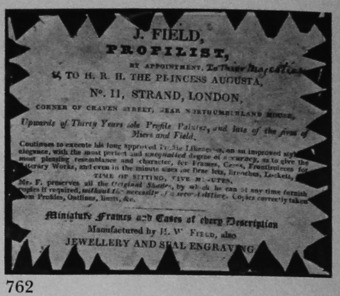
Trade Label No. 2 of John Field
Mr and Mrs J. H. Gutteridge collection
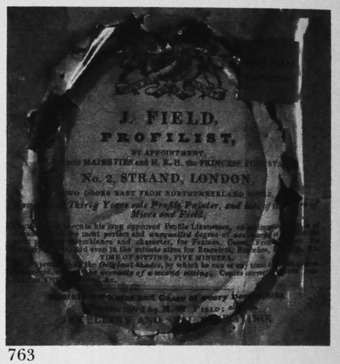
Trade Label No. 3 of John Field
Mrs Peggy Hickman collection
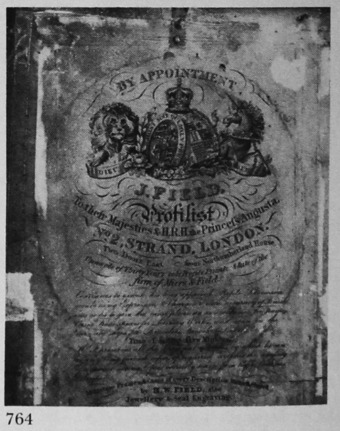
Trade Label No. 4 of John Field.
Author’s collection
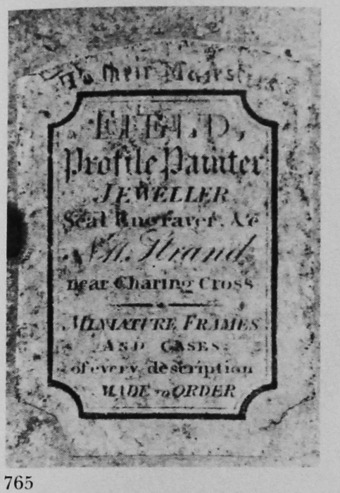
Trade Label No. 5 of John Field.
Size: 1¼ x 7/8in./32 x 23 mm.
Author’s collection
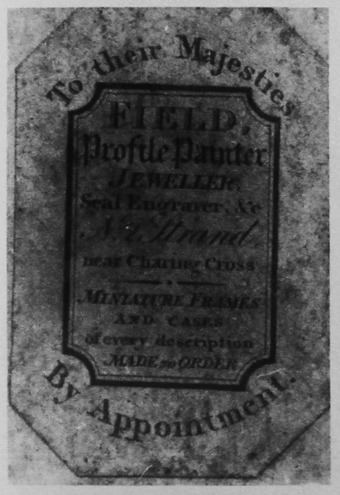
Trade Label No. 6 of John Field.
Size: 1¼ x 7/8in./32 x 23 mm.
Author’s collection
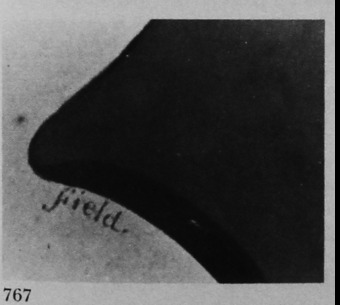
From a silhouette painted on card. Field sometimes began his surname with a small ‘f. he may have used a pen for this signature.
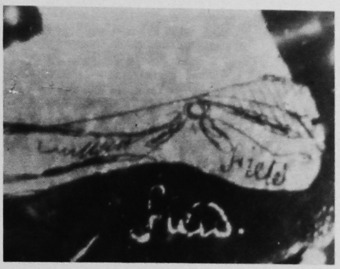
From a silhouette painted on glass.
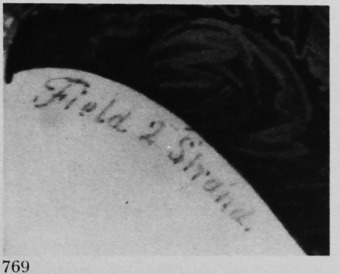
From a silhouette painted on ivory; this detail shows the artist’s intricate brushwork. The ‘t’ in ‘Strand’ has no cross-bar.
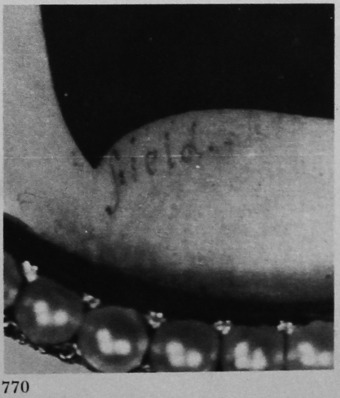
From a silhouette painted on ivory.
